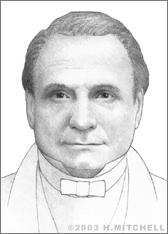Charles Babbage
Mathematician Charles Babbage is credited as being one of the forefathers of the computing era. It is said that the use of Jacquard punch cards, chains, and subassemblies, and the logical structure of the modern computer all stem from his early ideas. Born on December 26, 1791 in Teignmouth, Devonshire, outside London, he entered Trinity College in 1811 where it was clear that he knew more than the majority of his tutors. By 1816 he was well known throughout academic circles and was elected a Fellow of the Royal Society. He earned his master’s degree from Trinity in 1817.
Babbage helped found the Astronomical Society in 1820, and it was at that time that he first became interested in calculating machinery. Babbage, like Isaac Newton, believed there was a distinct order to the universe, that basically once all things were quantified, all things could be predicted. In 1821, he invented the Difference Engine No. 1, a machine designed to compile mathematical tables. Despite its imperfections, this is considered to be the world’s first successful automatic calculator. Though Blaise Pascal built a crude calculator in 1642, his was extremely unreliable.
From 1828 to 1839, Babbage held the Lucasian chair of mathematics at Cambridge University, which Isaac Newton and Stephen Hawking have also held during their lifetimes. He began working on a new Difference Engine in 1832 and completed an initial prototype, but he was forced to end the project in 1842. Challenged by things mechanical in nature, many of his models were not received as well as they might have been. Often, as in this case, he suffered from a lack of funding. In 1854, however, Swedish printer George Scheutz successfully constructed a machine based on Babbage’s Difference Engine designs. It printed mathematical, astronomical, and actuarial tables accurately and was used by the British and American governments.

The Analytical Engine, Babbage’s second and more complex design, was started unofficially in 1937, when he began thinking of a machine that could be programmed like a modern computer – that could receive and understand a set of commands. A very rough and unreliable model of the Analytical Engine was the only version of the design that Babbage was able to complete. But the important thing was that the concept of programming had been introduced to the world for the first time.
Babbage died on October 18, 1871. He left a legacy that was bigger than life, having also invented a dynamometer, Britain’s first cow catcher, a standard railroad gauge, occulting lights for lighthouses, Greenwich time signals, and a heliograph opthalmoscope. He helped to advance the British tool industry with his designs for lathes and tool-shapers and even contributed to the introduction of the first standard screw threads. His was the idea to instate uniform postal rates.
On the moon, there is a crater bearing Babbage’s name. In addition, his brain was preserved in alcohol until 1908, when Sir Victor Horsley of the Royal Society dissected and studied it. And today, the Charles Babbage Foundation is named in his honor in recognition of his intellectual contributions and their influence on the modern computing world.


